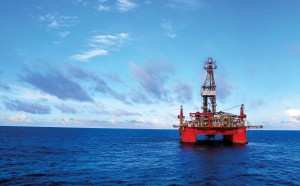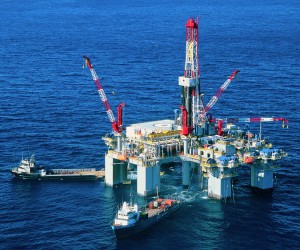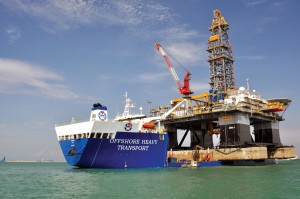Navigating safe waters
Industry takes proactive approach to safety while anticipating GOM ramp-up
By Katie Mazerov, contributing editor

Booming markets in West Africa, Brazil and areas of Asia Pacific are putting a bullish spin on the overall offshore outlook, with rising utilization and dayrates in all sectors, including shallow- and mid-water, deepwater and ultra-deepwater. But all eyes are on the Gulf of Mexico (GOM), where a wait-and-see attitude prevails as a host of new regulations and compliance measures – with more anticipated — take hold as deepwater activity begins to ramp back up following an exodus of rigs from the region in the wake of the moratorium.
November 2011 marked the deadline for operators to implement and contractors to demonstrate capability to perform their work to meet the sweeping safety and environmental management system (SEMS), a 13-section program mandated by the US Bureau of Safety and Environmental Enforcement (BSEE) that addresses all aspects of safety management, including training, hazards analysis, incident investigation, and emergency response and control.
The regulation, requiring operators to establish SEMS, is based on API Recommended Practice (RP) 75, or SEMP, first written in 1993. But until November 2010, compliance with RP 75 was voluntary. The regulation requires operators to certify that their drilling contractors and other contractors have acceptable safety management and are capable of doing the work they are contracted to perform.
“Most major operators and drilling contractors have, for years, been running SEMS based on the principles of RP 75, which is good,” said Charlie Williams, executive director of the Center for Offshore Safety (COS). “There are some companies that did not have systems in place or had systems that needed improvement.”
Launched in March 2011, the center’s mission is focused on the GOM, specifically deepwater, but it is also developing tools that will be used for the entire US Outer Continental Shelf.
“The idea for the center came out of the API Upstream Committee and actually predated the Presidential Commission report that was issued post-Macondo,” Mr Williams said. “Until now, our work has been focused on developing a SEMS toolkit to assist people in complying with workplace safety rules.”

But there are three key elements to the center’s overall purpose. The first involves auditing, building audit tools for SEMS, developing third-party auditor training programs and auditor certification, and auditing the auditors to ensure they are compliant with the SEMS requirements.
The second is to develop good practices and tools that can help people build more effective SEMS. To that end, the COS is facilitating ongoing industry workshops, the first one on leadership. “This is important because one of the key drivers to developing a strong safety culture and building an effective SEMS is to demonstrate leadership and commitment in site visits,” Mr Williams said.
“The people on the rigs must see company leaders embrace the program. You can have a great SEMS system, but people must be motivated to use it every day, all day long. It’s a constant journey of awareness.”
A second workshop focused on ways to measure the effectiveness of SEMS, including measures to help detect incidents in advance or identify weaknesses in the system. Teams of industry professionals, formed at the initial workshops, are continuing to meet.
The third element involves collecting data and measurements on incidents and good practices that can be used to gauge the overall health of the industry, information that can be shared within the industry and with BSEE. This will include data from audits to derive learning and help determine what needs to be improved.
“The COS wants to bring people in the industry together to share information and lessons and determine if there are gaps to making the systems better,” Mr Williams said.
Positive Industry Response
Response to the COS has been positive, with most of the work thus far achieved by volunteers. The agency’s Board of Governors includes 22 representatives from all sectors of the industry. The intent is to get everyone to join, starting with companies involved in deepwater. “As we develop and expand, we’ll start signing up others,” Mr Williams said.
Global interest has also been significant. “This is really a system about managing and delivering safety that can be applied anywhere in the world,” he stated.

But uncertainty lingers as the regulations have not been finalized. “There are still questions on what the new BSEE rules will be, especially for blowout preventers,” said Moe Plaisance, vice president of contracts and marketing for Diamond Offshore Drilling and a member of the COS Board of Governors. “BSEE has also announced it is coming out with some additional regulations, so this issue has not been fully defined.”
From Mr Plaisance’s perspective, SEMS has gotten off to good start and has not been onerous in terms of compliance. “We’ve had a very robust safety management system in place for many years at Diamond, and we have been able to get with our operators and bridge our system with theirs, which is what SEMS is designed to do,” Mr Plaisance said. “Our Global Excellence Management System (GEMS) is very compatible with SEMS.”
He also believes that while SEMS has been an awakening for smaller operators, it has not been burdensome for the majority of companies that have had safety management systems in place for many years.
What SEMS addresses is the human side of the safety issue, which is the most important factor, Mr Plaisance maintains. “It is still critical to have people trained to know how to respond to an event than try and overdo mechanical issues,” he noted. “The key point to realize is that the industry is moving ahead and putting our problems behind us in an exemplary manner.”
Diamond has moved several rigs out of the GOM over the past 18 months. Whereas the company had 10 rigs operating in the region two years ago, it has only one now – the Ocean Victory, which is doing intervention and abandonment work in 1,500-ft water depths in the central GOM, Mr Plaisance said. The company had moved some rigs to the robust Brazil market prior to the moratorium; the rest were shifted after the slowdown and remain under contract with international customers.
“We’ll see rigs start to come back by the end of the year and into the following year,” he predicted.
Dayrates Rising
Meanwhile, Diamond is active in all the major deepwater regions. “We’re very upbeat about the market with crude oil prices where they are now,” he continued. “The current wide differential between West Texas Crude and Brent is an indicator that markets are going to improve. Utilization is 100% of what we want to market.”
Dayrates are rising through the spectrum of floating rigs, with ultra-deepwater prices from the mid-$500,000s to over $600,000, he said.
Deepwater West Africa is a huge potential growth market, as evidenced by discoveries in Angola, along with continuing activity in the traditional West African countries, Mr Plaisance added. But East Africa is also on the rise, particularly with the success companies have had in Mozambique and Tanzania.

“That’s been an area that, years ago, the industry wrote off as not productive. But we’ve found opportunities in the deeper waters,” he said. Diamond has one rig in Angola, one in Equatorial Guinea and one in Egypt, all big floating rigs.
In North Africa, recent gas discoveries in Egypt, Israel and Cyprus are indicative of significant natural gas finds, which would provide opportunities for those countries to gain cheap domestic fuel for their industries and economies.
Significant events in South America include discoveries by Brazilian independent OGX and ongoing development of the pre-salts by Petrobras. Diamond has 14 rigs in Brazil, the company’s largest area of operation. “Oil discoveries in French Guyana, along northern coast of the continent, analog with those in Ghana in West Africa,” Mr Plaisance said.
Confidence in GOM Permitting
“We’re seeing demand increasing in oil markets in the traditional North Sea region, particularly for mid-water, harsh-weather rigs,” he added. “There is also strong activity in Indonesia, Malaysia and Australia.”
Diamond is increasing its ultra-deepwater capacity with three new drillships being built in Korea, as well as its deepwater capacity with the Ocean Onyx, which is currently in the AmFELS shipyard in Brownsville, Texas.
Ensco has two rigs scheduled for deployment in deepwater GOM this year, including the ENSCO 8505 that is being outfitted in Corpus Christi and will begin working in the second quarter under a contract with Anadarko Petroleum, Apache Deepwater and Noble Energy. The initial contract term is for two years or two rotations per operator, whichever is longer, at a dayrate of $475,000 plus cost adjustments, the company announced last year.
Ensco has five deepwater rigs and 11 jackups already working in the GOM, as well as four jackups working for PEMEX in the Mexican Gulf.

“Deepwater activity in the GOM continues to strengthen as operators gain confidence in the permitting process,” said David Hensel, Ensco vice president, North and South America. “Operators are now getting permits far enough in advance to effectively plan ongoing operations and avoid breaks in drilling programs. We have also seen increased demand, as evidenced by our contracts for ENSCO 8505 and ENSCO 8506,” he said.
Earlier this year, the ENSCO 8506 entered a two and a half-year contract with Anadarko in the GOM, at a dayrate of $530,000 plus cost adjustments. Delivery is scheduled for the third quarter this year, with deployment anticipated for fourth quarter 2012.
The ENSCO 8505 and 8506 rigs are the two final rigs in the ENSCO 8500 Series that began operations in the GOM in 2009, drilling the significant Lucius discovery for Anadarko. The rigs can be modified to drill and complete wells in water depths up to 10,000 ft.
Focus on Integrity
Beyond the GOM safety regulations, the offshore industry as a whole has taken time out to revise, rethink and improve processes, rather than respond to countries or regions putting regulatory mandates in place, said Rodrigo Rendon, head of business development for international drilling contractor KCA DEUTAG. The company, which does not operate in deepwater or the GOM, is taking a serious and proactive approach in implementing the lessons learned from Macondo in its offshore markets in the Caspian Sea, Sakhalin Island in Russia, Azerbaijan, West Africa (Gabon, Angola and Nigeria), Mexico, the North Sea and Southeast Asia.

“Whether we call it SEMS or whatever name, as an industry, there is a lot of focus on operational and technical integrity,” he said. “The most deliberate action we have taken is the creation of a senior vice president of operations position, one level below the board, that is ultimately responsible for this area,” he continued. “Under that position are technical authorities who have the last say on whether an operation goes forward or not and who will dictate operational procedures.”
The company has also revised all its well control procedures and issued new well control guidelines and rules in the form of cards that are distributed to people on rigs, providing pragmatic directives on what to do in the event of an incident, he said.
After hitting a low point a year ago, the shallow drilling market is fairly healthy in terms of dayrates and utilization, both of which are increasing. Mr Rendon attributes the uptick to stable oil prices that are giving operators confidence to undertake exploration and sanction projects going to development phases.
“Our jackups are fully utilized with a good backlog of contracts. For traditional jackups, we are seeing rates above $100,000 per day,” he said. “Utilization is growing in Asia Pacific and Africa. West Africa continues to be a very good market, and now East Africa is beginning to gather some attention in all sectors – land, shallow and deepwater.”
The company also has a healthy tender barge business, with two units coming off contract this year. Last year, KCA DEUTAG acquired Singapore-based Global Tender Barges, which significantly bolstered the company’s mobile offshore drilling unit division, Mr Rendon noted. The company is also engineering a design for a semisubmersible tender assist.
ENSCO 8500 Series is a registered term of Ensco plc.
Editor’s Note: Moe Plaisance has assumed a new role at Diamond Offshore Drilling. He is now vice president of government & industry affairs.




